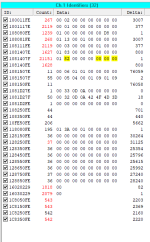Depends on your plug. probably you have a different version.
I had four versions plugs until today and all worked with the black wire from start. The plug next to it is CAN.
The fourth not on my picture has 3 more wire pairs on the right side.
125KB/s
Permanent set (offline voltage) 56V permanent Data 01 01 00 00 00 00 E0 00 probably the PSU overshoots by 0,3V so try DE EC or anything in between. Changes will show up after 30 seconds.
If you want to see the changes immidiatly (online voltage) 01 00 00 00 00 00 E0 00 , but they will get lost after 30 seconds or after a new start..
I had four versions plugs until today and all worked with the black wire from start. The plug next to it is CAN.
The fourth not on my picture has 3 more wire pairs on the right side.
| CANID HEX | 10 80 80 FE | broadcast to all rectifiers | |
| Data | 01 00 00 00 00 00 xx yy | online voltage | |
| Data | 01 01 00 00 00 00 xx yy | offline voltage | |
| Data | 01 02 00 00 00 00 xx yy | overvoltage Protection | |
| Data | 01 03 00 00 00 00 xx yy | online current | |
| Data | 01 04 00 00 00 00 xx yy | offline current |
Permanent set (offline voltage) 56V permanent Data 01 01 00 00 00 00 E0 00 probably the PSU overshoots by 0,3V so try DE EC or anything in between. Changes will show up after 30 seconds.
If you want to see the changes immidiatly (online voltage) 01 00 00 00 00 00 E0 00 , but they will get lost after 30 seconds or after a new start..








